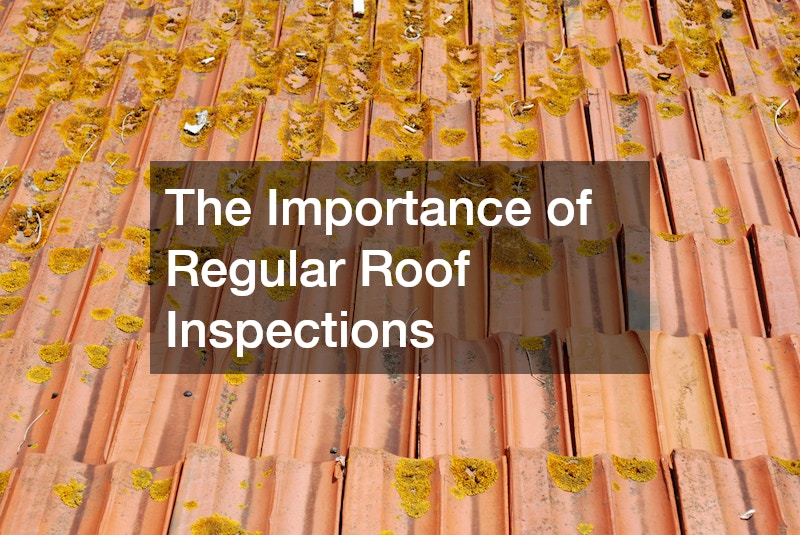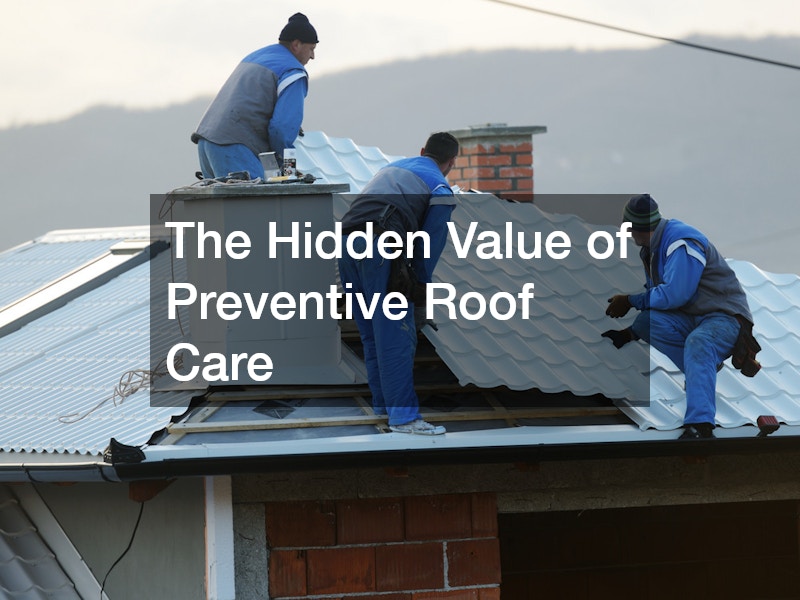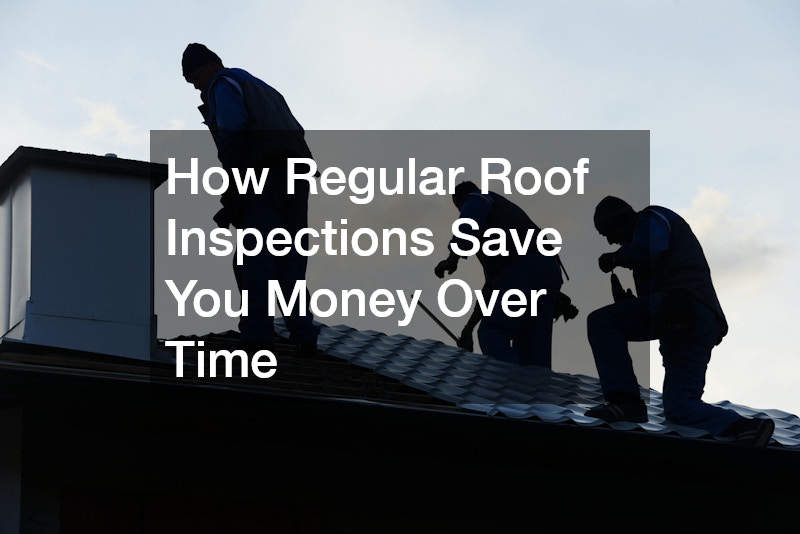Your roof quietly works day and night, protecting everything you love beneath it — your home, your memories, and your sense of comfort. Yet, it’s also one of the most overlooked parts of a property. Most homeowners don’t give it a second thought until something goes wrong: a leak after a storm, missing shingles, or sudden water stains on the ceiling. By that point, the damage — and the repair bill — can be significant.
That’s why regular roof inspections are one of the smartest financial decisions you can make for your home. Far from being an unnecessary expense, inspections are an investment in your home’s long-term stability and safety. They help catch small issues before they snowball into major local roof repairs and, ultimately, save you thousands over time.
Let’s take a closer look at how scheduling regular inspections can protect your roof, extend its life, and keep your budget intact.

The Importance of Regular Roof Inspections
What Roof Inspections Involve
A roof inspection is like a full-body checkup for your home. It’s a detailed evaluation that helps identify existing issues and potential trouble spots long before they cause serious damage.
During a standard inspection, a professional will look for signs of wear and tear — loose shingles, cracked flashing, damaged seals around vents or skylights, and clogged gutters. They’ll also check the attic for moisture, mold, or poor ventilation, which can indicate hidden leaks.
Some homeowners assume that a quick glance from the ground is enough, but real assessments require a trained eye. Professionals are trained to spot subtle problems that an untrained observer might miss. They can tell whether a small crack is harmless or a sign of deeper structural weakness.
Recommended Frequency of Inspections
As a general rule, you should schedule a roof inspection at least twice a year — once in the spring and again in the fall. These times bookend the harsher weather seasons, helping you prepare your roof for summer heat and winter storms.
It’s also wise to schedule an inspection after any severe weather event such as hail, heavy rain, or strong winds. Even if the damage isn’t visible from below, shingles can loosen or seals can weaken. By addressing those issues early, you prevent small repairs from turning into major renovations later.
If you’re unsure how your roof has been performing, reach out to a trusted roofing contractor in your area. They can offer expert insight into your roof’s current condition and give recommendations based on local climate and materials.
Preventing Small Problems from Becoming Big Expenses
Early Detection of Damage
Roof damage rarely happens overnight. It usually starts small — a few missing shingles, a tiny crack, or a slow leak — and gradually worsens. By the time water stains appear on your ceiling, the underlying structure could already be compromised.
Regular inspections are your first line of defense. They allow professionals to catch minor issues before they cause widespread damage to insulation, framing, and drywall. A small repair that costs a few hundred dollars today could save you from a $10,000 roof replacement down the line.
For example, one homeowner might overlook a little moisture spot in their attic. After a year or two, that same spot can lead to mold growth, warped beams, and costly restoration work. Regular inspections stop this chain reaction before it begins.
Protecting Structural Integrity
Your roof isn’t just the top of your house — it’s a crucial part of your home’s overall structure. A damaged roof can affect everything beneath it. When leaks go unchecked, they can cause wood rot, weaken the ceiling joists, and compromise insulation.
Consistent inspections help protect that structure. By sealing small cracks and replacing damaged shingles early, you prevent moisture from seeping in. That protection extends beyond comfort — it safeguards your home’s safety, durability, and even resale value.
If you’ve recently moved into an older home, it’s especially important to schedule an inspection. A local roofing company can identify lingering issues left by previous owners and help you plan an affordable maintenance schedule going forward.

Extending the Lifespan of Your Roof
Preserving Roofing Materials
Every roof, no matter how well built, has a natural lifespan. Asphalt shingles typically last 20–30 years, while metal or tile roofs can last much longer. However, neglect can shorten that lifespan dramatically.
Routine inspections allow you to maintain the roof’s materials in top shape. Cleaning gutters, sealing flashing, and replacing worn shingles all prevent premature deterioration. The longer your roof lasts, the fewer replacements you’ll need — saving you thousands over time.
Think of inspections like regular car maintenance. You wouldn’t wait until your engine failed to change the oil. The same logic applies to your roof — small, consistent care keeps everything running smoothly for decades.
If you’re planning an update in the future, a residential roofer can help you assess whether it’s time for a partial repair or full renovation based on what your current materials can handle.
Maintaining Manufacturer Warranties
Most roofing warranties require proof of regular maintenance and inspections. If you skip those steps and later file a claim, the manufacturer may deny coverage because of neglect.
Having professional documentation from scheduled inspections proves you’ve cared for your roof properly. That record can make the difference between a covered repair and a large out-of-pocket expense.
This is another reason why partnering with a reputable roofing company matters — they’ll keep track of maintenance records for you and make sure your roof remains eligible for warranty protection.
Avoiding Emergency Repairs
The High Cost of Neglect
There’s nothing worse than waking up to a leak during a storm or discovering water damage after months of unnoticed wear. Emergency repairs are stressful, expensive, and often preventable.
A single emergency visit can cost several times more than a scheduled inspection or minor repair. That’s because roofers often need to respond immediately, work under difficult conditions, and replace damaged materials quickly.
By contrast, a routine inspection costs much less and can catch those vulnerabilities before they turn into emergencies. Preventive care may not feel urgent, but it’s almost always cheaper than emergency intervention.
If you’re comparing service providers, look for a company that offers an ongoing roofing service plan. These programs include scheduled checkups and discounts on maintenance, helping you budget and avoid surprise costs.
Peace of Mind for Homeowners
A well-maintained roof offers something money can’t buy — peace of mind. You’ll sleep easier knowing your home is protected, even in heavy rain or high winds.
Regular inspections take the guesswork out of maintenance. You’ll know exactly what shape your roof is in, what needs attention, and when. That clarity helps you plan financially, avoiding the panic of unexpected repair bills.
For families balancing mortgage payments and home upgrades, this level of predictability makes homeownership less stressful and more rewarding.

Enhancing Energy Efficiency and Home Value
Better Insulation and Ventilation
Roof inspections aren’t just about shingles — they’re also about energy efficiency. When inspectors check your attic, they’re looking for proper insulation and airflow. A poorly ventilated roof can trap heat and moisture, raising your energy bills and causing long-term damage.
During an inspection, professionals can recommend adjustments like adding vents or sealing gaps. These small upgrades make your home more comfortable year-round and can reduce heating and cooling costs.
If your roof needs an upgrade, ask about modern materials that improve energy performance. A new roof installation can incorporate reflective surfaces and ventilation systems designed to regulate temperature naturally.
Increasing Property Value
A well-maintained roof is one of the first things buyers notice — and one of the most reassuring. It signals that the home has been cared for, minimizing worries about hidden damage.
Documented inspection records can even serve as proof during a home sale. Buyers are far more likely to pay the full asking price when they know the roof has been consistently maintained.
In other words, a few scheduled inspections can translate into thousands of dollars in added resale value. That’s a long-term return few other home investments can match.
Working with Trusted Roofing Professionals
Why Hire Local Experts
When it comes to maintaining your roof, experience matters. Local professionals understand the specific weather patterns and building codes in your area, making them better equipped to identify and fix problems before they escalate.
Working with roofing companies near you also makes scheduling easier — they can respond quickly, especially after storms. Local experts know which materials perform best in your climate and which maintenance plans deliver the most value.
Unlike large national chains, local professionals rely on word-of-mouth reputation. That means they’re more likely to prioritize customer satisfaction, quality materials, and honest recommendations.
What to Look For in a Roofing Company
Choosing the right roofer starts with research. Look for licensed and insured professionals with years of experience and strong community references.
Ask for detailed inspection reports that outline what was checked, what was repaired, and what might need attention in the future. Transparency is a sign of reliability.
If you’re unsure where to start, talk to local roofers who offer maintenance packages. They’ll help you create a long-term plan to protect your roof and provide personalized service that fits your home’s unique needs.

The Hidden Value of Preventive Roof Care
Saving More Than Just Money
While financial savings are the most obvious benefit of regular inspections, the emotional and practical advantages are equally important. Maintaining your roof means protecting your peace of mind, your property’s comfort, and even your family’s safety.
You won’t have to worry about leaks disrupting family gatherings, mold affecting indoor air quality, or roof damage compromising your home’s foundation. Instead, you can focus on enjoying your home, confident that it’s safe and sound.
Consistent care also reduces waste. Fewer full roof replacements mean fewer materials sent to landfills, making your choice an environmentally responsible one as well.
Setting a Good Example for Homeownership
Your roof is one of your home’s biggest investments — treat it that way. Setting a regular inspection schedule shows pride in ownership and attention to detail.
It also teaches younger homeowners the importance of preventive maintenance. In many ways, your diligence today sets the standard for how they’ll care for their homes tomorrow.
When to Schedule Your Next Inspection
Seasonal Considerations
Spring and fall remain the best times for roof inspections. After winter, check for damage from snow and ice; before winter, make sure your roof can handle upcoming storms.
If you live in an area with heavy rainfall or high humidity, you may need to schedule more frequent inspections. High temperatures and strong UV rays can also wear down roofing materials faster.
Whenever you’re in doubt, reach out to local roof installers who can recommend the best inspection schedule for your climate and roofing type.
After Major Weather Events
Even if your roof looks fine from below, hail or strong winds can cause hidden damage. Schedule a professional visit whenever your area experiences severe weather.
Early intervention prevents moisture from sneaking into cracks or under shingles — problems that often worsen over time. Documenting these inspections also helps with insurance claims if storm damage occurs later.
How to Prepare for an Inspection
Step One: Clear Access
Make sure your roofer can safely access your roof and attic. Trim back branches, clear debris, and remove stored items that might block attic entry.
Safety is always the top priority. Clearing the area ensures a thorough inspection and helps roofers work efficiently.
Step Two: Take Notes and Photos
Before the inspection, jot down any leaks, drafts, or visible damage you’ve noticed. Photos can help track changes over time.
This information gives your roofer valuable context and makes it easier to compare future results.
Step Three: Review the Report Carefully
After the inspection, your contractor will provide a detailed summary of findings. Ask questions, request photos, and make sure you understand each recommendation.
If a repair is needed, schedule it sooner rather than later. Postponing small fixes often leads to larger costs later.
Long-Term Financial Benefits
Reducing Insurance Claims
Many homeowners don’t realize that regular roof maintenance can influence insurance premiums. Insurers view well-maintained homes as lower-risk, which may lead to reduced rates or easier claim approvals.
By preventing leaks and damage before they happen, you also minimize the number of claims you need to file — keeping your policy clean and affordable.
Avoiding Hidden Costs
A leaky roof doesn’t just damage ceilings; it can also harm electrical systems, flooring, and insulation. These indirect costs add up quickly.
Regular inspections catch water intrusion early, saving not just on roof repairs but on secondary home restoration as well.
With the help of a skilled maintenance plan, you’ll avoid sudden expenses that can derail your household budget.
Caring for Your Home Year-Round
Coordinating with Other Home Services
Roof inspections often go hand in hand with other seasonal home care tasks. While your roofer checks for leaks and wear, it’s also a good time to clean gutters, trim overhanging branches, and inspect your foundation.
For complete home care, coordinate roof maintenance with HVAC tune-ups, plumbing checks, and exterior cleaning. A healthy roof contributes to a healthy home — everything works together.
If your property includes detached garages or sheds, consider scheduling inspections for those, too. Smaller structures are just as vulnerable to weather and neglect.
Creating a Maintenance Calendar
Consistency is key. Mark two inspection dates on your calendar each year and stick to them. You can even align them with other home maintenance milestones — like air-filter changes or lawn-care schedules — to keep everything organized.
Keeping a record of inspection reports and local roof repairs creates a paper trail that proves your dedication to upkeep. This documentation can be invaluable for resale, warranty claims, or insurance reviews.
Your roof isn’t just a layer of protection — it’s an investment that shelters everything you hold dear. Regular inspections are the most cost-effective way to protect that investment, extending your roof’s lifespan and saving you from unexpected expenses.
By catching small problems early, maintaining your materials, and working with trusted professionals, you’ll enjoy a safer, more comfortable, and more energy-efficient home for years to come.
Whether your house is brand new or decades old, it deserves the kind of care that only consistent inspections can provide. Schedule your next checkup today, and take pride in knowing you’re not just maintaining a roof — you’re preserving the heart of your home.



